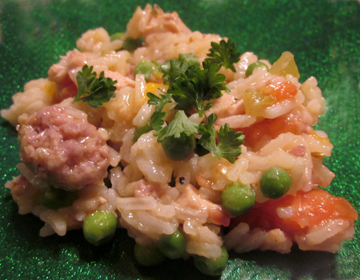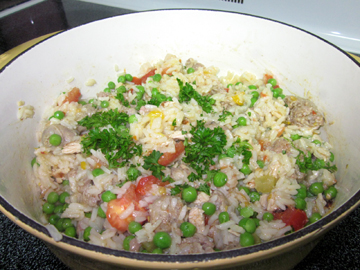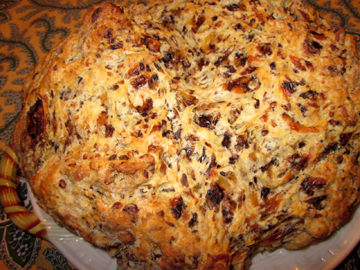
Tomorrow is Mardi Gras. If I had the time—and the waistline—I’d make a King Cake and maybe some beignets. (I’ve never made beignets, but there’s always next Mardi Gras.)
Instead this past weekend I paid tribute to the holiday with my favorite Louisiana main dish, Jambalaya.
I first encountered Jambalaya (or a form thereof) in college. The cooks at Mount Holyoke included something they called “Creole Jambalaya” on their monthly menu.
In general, the food at Mount Holyoke was pretty tasty. As I recall, however, the Jambalaya was neither tasty nor Jambalaya. It was creamed shrimp and some sort of other protein served over rice. I was unimpressed.
In Knoxville, Tennessee, however, I learned that I like Jambalaya A LOT.
My roommate at the University of Tennessee, Alice Gagnard, hailed from Alexandria, Louisiana. Alice made fabulous Cajun food.
The gumbos! The po’ boys! The Jambalaya!
I hope this coming summer to share with you the po’ boys Alice makes with her husband Kevin.
Meanwhile here is a recipe for Jambalaya.
This dish is appealing on a lot of levels. First, it is relatively inexpensive to prepare since you can mix in a combination of whatever forms of protein suit your budget (or lurk in your refrigerator). In addition to the chicken and sausage below, Jambalaya may be enjoyed with ham, shrimp, and even crawfish.
Second, its form (or lack thereof; it’s a very flexible food) reflects the mixed heritage of Louisiana itself, where French, African, Native American, English, and Spanish influences abound.
In an article titled “Jambalaya by Any Other Name,” food and travel writer Andrew Sigal describes his extensive research into the possible origins of the dish. He concludes that different cooks (and fans) may always have different ideas about where it came from.
He does note that that the Provençal term “jambalaia,” from which scholars believe Jambalaya got its name, originally meant “a mish-mash, rabble, or mixture.”
This pretty much sums up Jambalaya as far as I’m concerned. How can one not love preparing a recipe that means “rabble” and that sound like “jumble”?
Happy Mardi Gras! I can’t find most of my Mardi Gras attire, alas, so I leave you with a photo of me from a couple of years ago when I made King Cake.

Ingredients:
1 pound sausage (for true—but very dominant—Louisiana flavor, use andouille, but you may also use plain old kielbasa), cut into bite-sized pieces
extra-virgin olive oil as needed for frying
1 medium onion, finely chopped
1 to 2 stalks celery, finely chopped
1/2 bell pepper, finely chopped
1 clove garlic, finely chopped
butter if needed for frying
2 cups cut-up cooked chicken
1-1/2 teaspoons Creole seasoning, plus more if needed
chopped hot pepper (fresh or pickled) to taste—start out with 1/2 teaspoon to a teaspoon; then add more the next time if you want your Jambalaya spicier
4 cups chicken stock, divided
1-1/2 cups uncooked rice
1 large or 2 small tomatoes, roughly chopped
2 cups cooked peas
lots of chopped fresh parsley
Instructions:
In a heavy Dutch oven brown the sausage pieces. If they are not very fatty and start sticking a lot, splash in a little olive oil. If they are very fatty, drain some of the fat off when they have browned. Remove the sausage and set it aside.
In the fat (plus a little olive oil and butter if needed) sauté the onion, celery, bell pepper, and garlic. Cook them until they soften and begin to smell wonderful. Use their juices and the fat in the pan (plus a spatula or wooden spoon) to scoop up any brown bits from the bottom of the pan.
Return the sausage to the pot, along with the chicken, the seasoning, the hot pepper, and 1 cup of the stock. Bring the mixture to a boil. Cover, reduce the heat to low, and simmer gently for 1/2 hour, stirring from time to time.
Add the remaining stock. Bring the mixture to a boil, and stir in the rice. Return the mixture to boiling, stir, and reduce the heat and cover again.
Simmer until the rice is cooked through but not dry, about 1/2 hour longer. Taste for seasoning and add a little more spice if you like.
Stir in the tomatoes and peas. Sprinkle parsley overall and serve with Tabasco sauce on the side.
Serves 6.

